Reproduction, Fertility and Development
Volume 25
Number 7 2013
Various intraovarian chemical transmitters are important for gamete development, a process that depends on communication with neighbouring cells. One of the many functions controlled by intraovarian transmitters is ovarian cell death, which is important in phenomena such as ovulation and tumourigenesis. In the present study, we show that extracellular ATP acting on specific membrane receptors expressed in the ovarian epithelium induces cell death in this layer, and that this action is regulated throughout the oestrous cycle, suggesting a role for ATP signalling during ovulation.
The regulation of uterine function is a complex multifactorial process, considered paramount for equine fertility. The present study investigated the presence of cytokines (tumour necrosis factor (TNF)-α, interferon-γ, Fas ligand) and their receptors in the mare endometrium and the ability of TNF-α, together with steroid hormones and oxytocin, to modulate endometrial physiology. A coordinated action between cytokines and ovarian hormones may regulate secretory, vascular and proliferative functions in the equine endometrium.
There are some hormonal techniques (eCG administration), used to improve fertility in cattle, which change the organism’s capacity to produce progesterone; however, the basis for this is yet not completely understood. The present work reveals some of the molecular pathways triggered by eCG and helps our understanding of which mechanisms to target in order to enhance reproductive rates.
Literature shows that women can fall pregnant with another baby whilst being already pregnant (this is called superfetation). This review evidences a small discordance between gestational age in superfetation twins (range: 2–4 weeks). This difference is compatible with an atypical increase in oestradiol levels in the luteal phase occurring between 1 and 3 weeks after the ovulation that allowed the first pregnancy. However, the likelihood of the occurrence of superfetation in humans is extremely low.
In the present study, the pain and stress responses to tail removal (female and male lambs) and castration (male lambs) were investigated. Plasma cortisol and adrenocorticotrophin concentrations increased after the procedures in both sexes, with less consistent responses in endorphin levels. Prenatal exposure of the fetus to dexamethasone blunted the cortisol response to tail removal in female lambs, but did not affect the response to the combined procedure in males, suggesting sex differences in the development of the hypothalamic–pituitary–adrenal axis.
To improve embryo in vitro production techniques, it is necessary to understand the variables involved in the process. In the present study we investigated the control of glycolysis, a key metabolic pathway involved in cell energy production, in cumulus–oocytes complexes during IVM and revealed a link between glycolytic activity and the oxidative and mitochondrial metabolism of the oocyte. The findings of the present study will help us understand the relationship between the glycolytic pathway in cumulus cells and events related to the maturational capability of the oocyte.
The aim of the present study was to investigate whether reduced glutathione (GSH) and procaine hydrochloride (ProHCl) were able to counteract the destabilisation of nucleoprotein structure of the sperm head that usually occurs during boar sperm cryopreservation. When GSH and ProHCl were added to freezing extenders at a final concentration of 2 mM, the number of non-disrupted sperm head disulfide bonds after thawing was higher than the negative control. In conclusion, adding GSH and ProHCl to freezing extenders is beneficial for the stability of nucleoprotein structure of cryopreserved boar spermatozoa.
Laboratory rats are commonly used experimental animal models in many areas of biomedical research to gain a better understanding of the genetic basis of human diseases. In contrast with spermatozoa from other mammalian species, rat spermatozoa are known for their hypersensitivity to physical interventions, such as handling, centrifugation, gradient separation, hypothermia and freezing. The present study provides fundamental information on the detrimental effects of reactive oxygen species and mitochondrial dysfunction on rat sperm motility after the application of physical stress.
In the dog, oocyte maturation, fertilisation and early embryo development take place in the oviduct in the presence of high progesterone levels. To investigate the potential effects of progesterone in the canine oviduct, the expression and localisation of nuclear and membrane progesterone receptors were examined for the first time at precise times around ovulation. Our results support the hypothesis that progesterone is an important regulator of oviductal functions and gamete maturation through different complementary pathways.
The present study investigated the effects of oocyte morphology, incubation time and different supplements in the oocyte maturation medium on the number of chromosomal abnormalities in IVF-derived early bovine embryos. The results indicate that a combination of good-quality oocytes, a short incubation period and controlled culture medium can decrease the rate of chromosomal abnormalities, increasing the overall efficiency of cattle in vitro production.
Micronutrient (folic acid, vitamin B12) deficiencies during the preconception period play a critical role in determining pregnancy outcome. The current study demonstrates that folic acid and vitamin B12 deficiency leads to an abnormal oestrous cycle in rats, which can be ameliorated by omega 3 fatty acid supplementation. This study may have implications in fertility and pregnancy outcome.




